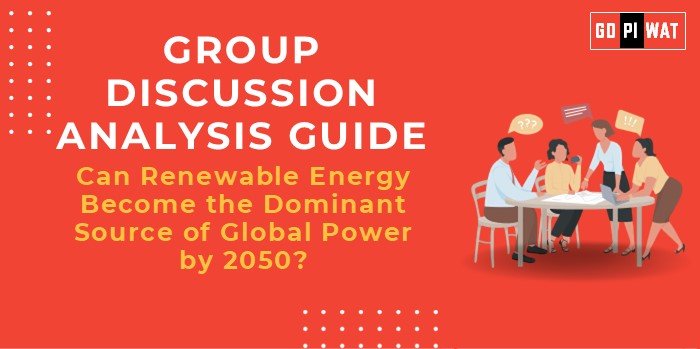📋 GROUP DISCUSSION ANALYSIS GUIDE
🌞 Can Renewable Energy Become the Dominant Source of Global Power by 2050?
🌟 Introduction to the Topic
Renewable energy is gaining global attention as an essential solution to combat climate change and ensure sustainable development. With advancements in technology and global commitments such as the Paris Agreement, the potential of renewables is immense. However, achieving dominance by 2050 remains a subject of intense debate, considering the economic, technological, and policy challenges.
📊 Quick Facts and Key Statistics
- 🌍 Global Renewable Capacity (2023): 3,372 GW, with solar and wind contributing the majority (IRENA, 2023).
- 🌿 Net Zero Pledges: Over 70 countries aim for carbon neutrality by 2050.
- 💰 Investment Growth: $495 billion invested globally in renewables in 2022, a 17% increase year-on-year (IEA).
- 🔋 Energy Share: Renewables accounted for 29% of global electricity generation in 2023.
👥 Stakeholders and Their Roles
- Governments: Policy frameworks, subsidies, and regulatory support for renewables.
- Private Sector: Investments in innovation, technology, and large-scale infrastructure.
- International Organizations: Guiding global policy, technical support (e.g., IRENA, UNFCCC).
- Citizens: Adopting sustainable practices and renewable energy technologies.
🏆 Achievements and Challenges
🌟 Achievements:
- 💵 Cost Reduction: Solar PV and wind costs have dropped by over 85% and 56%, respectively, since 2010.
- 🔬 Innovation: Energy storage technologies like lithium-ion batteries have improved efficiency.
- 🌐 Global Initiatives: Projects such as the International Solar Alliance aim for large-scale impact.
⚠️ Challenges:
- 🌤️ Intermittency Issues: Dependence on weather conditions affects reliability.
- ⚡ Infrastructure Gaps: Lack of grid modernization in many countries.
- 📜 Policy Barriers: Inconsistent regulations hinder progress in certain regions.
- 🌋 Resource Limitations: Critical minerals (e.g., lithium, cobalt) are required for renewable technologies.
Global Comparisons:
- 🇩🇪 Germany: Leads with over 50% electricity from renewables but faces grid stability issues.
- 🇨🇳 China: World’s largest renewables investor, focusing on solar and wind.
Case Studies:
- 🇮🇳 India’s Solar Parks: Projects like Bhadla Solar Park demonstrate scalable renewable energy solutions.
📑 Structured Arguments for Discussion
- Supporting Stance:
“Renewables are already cost-competitive with fossil fuels, positioning them as the future of energy.”
- Opposing Stance:
“The intermittency and resource limitations of renewables make a 2050 timeline unrealistic.”
- Balanced Perspective:
“While renewables have shown exponential growth, achieving dominance by 2050 depends on overcoming significant technological and policy challenges.”
✨ Effective Discussion Approaches
- Opening Approaches:
- 📊 Statistical Start: “Renewables contributed 29% of global electricity in 2023, but can this trend continue?”
- 📘 Case Study Mention: “India’s renewable projects, like Bhadla Solar Park, showcase scalability but highlight gaps in grid connectivity.”
- Counter-Argument Handling:
- Use data to rebut over-reliance on fossil fuels, emphasizing energy storage advancements.
🔍 Strategic Analysis of Strengths and Weaknesses
- 💡 Strengths: Cost efficiency, environmental benefits, scalability potential.
- ⚠️ Weaknesses: Intermittency, high upfront costs, grid infrastructure.
- 📈 Opportunities: 5G-enabled smart grids, global partnerships, green jobs.
- 🌋 Threats: Geopolitical conflicts over critical minerals, fossil fuel lobbying.
🏫 Connecting with B-School Applications
- Real-World Applications:
- 🔄 Explore projects integrating finance and technology for renewable scalability.
- Sample Interview Questions:
- “What are the key factors driving renewable energy investments?”
- “How can technology address the intermittency of renewables?”
- Insights for Students:
- 🔬 Opportunities in consulting for renewable energy firms.
- 📊 Scope for research in energy economics and policy modeling.


